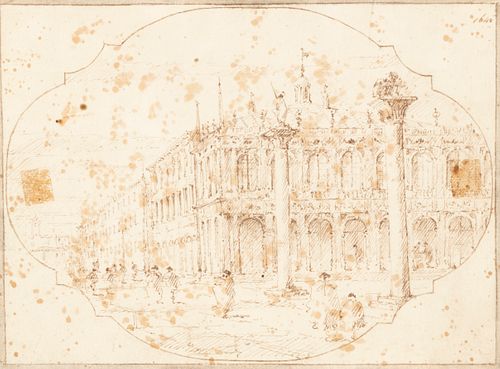Venetian School; last decade of the 18th century. "View of Venice". Drawing on paper.
Lot 34
About Seller
Setdart Auction House
Carrer Aragó 346
Barcelona
Spain
Setdart Subastas was born in 2004 and is currently the first online art auction in Spain with solidity, prestige and reliability guaranteed by our more than 60,000 users. Setdart has a young, dynamic and enterprising team ready to successfully manage the purchase and sale of art works through custom...Read more
Categories
Estimate:
EUR€1,200 - EUR€1,500
$1,304.35 - $1,630.43
Absentee vs Live bid
Two ways to bid:
- Leave a max absentee bid and the platform will bid on your behalf up to your maximum bid during the live auction.
- Bid live during the auction and your bids will be submitted real-time to the auctioneer.
Bid Increments
| Price | Bid Increment |
|---|---|
| EUR€0 | EUR€10 |
| EUR€200 | EUR€25 |
| EUR€500 | EUR€50 |
| EUR€1,000 | EUR€100 |
| EUR€3,000 | EUR€200 |
| EUR€5,000 | EUR€500 |
| EUR€10,000 | EUR€1,000 |
| EUR€20,000 | EUR€2,000 |
| EUR€50,000 | EUR€5,000 |
About Auction
By Setdart Auction House
Jul 14, 2021
Set Reminder
2021-07-14 06:30:00
2021-07-14 06:30:00
America/New_York
Bidsquare
Bidsquare : OLD MASTERS
https://www.bidsquare.com/auctions/setdart-auction-house/old-masters-7202
Setdart Auction House sofia@setdart.com
Setdart Auction House sofia@setdart.com
- Lot Description
Venetian School; last decade of the 18th century. "View of Venice". Drawing on paper. Presents rust stains. Size: 14,5 x 20 cm. In this work the artist shows us an image of St. Mark's Square in Venice, with the famous column, where the sphinx is currently located. In spite of the quick stroke behind the section of the ducal palace, which is included in the scene, the dome of St. Mark's can be appreciated. It is a work framed in the tradition of Venetian vedutismo, whose history begins in the eighteenth century, although it has antecedents dating back to the second half of the fifteenth century. Proud of its power, the city then considered queen of the Mediterranean due to its commercial contacts reinforced it through a true visual propaganda. With the precise and opportunely idealized representation of the scene of so many historical and legendary episodes, a myth was consolidated that was destined to endure over time, even if in the 18th century only shaky foundations remained to support it. On the other hand, the creation of the genre was also based on the influence of the Nordic painters who settled in Italy in the 16th century, many of them specialized in landscape painting (unlike the Italians, who concentrated mainly on the human figure). The new trend would soon become popular in Italy as well, although for the time being it remained confined to a minor genre. These Dutch and Flemish painters, settled in Rome, created views characterized by admiration and nostalgia for the beauty of the classical city, combined with the analytical description of details, typical of the Flemish tradition, which the Vedutists would eventually inherit. However, they are still views in which the urban setting is subordinated to a narrative episode. The term "vedutismo" itself defines a pictorial genre based on the representation of places in which buildings are present, sometimes populated by a more or less numerous number of characters. Therefore, the protagonist of the painting is the urban landscape, always represented according to the laws of perspective.
- Shipping Info
-
In-house shipping available. Please inquire at admin@setdart.com.
-
- Buyer's Premium



 EUR
EUR CAD
CAD AUD
AUD GBP
GBP MXN
MXN HKD
HKD CNY
CNY MYR
MYR SEK
SEK SGD
SGD CHF
CHF THB
THB













